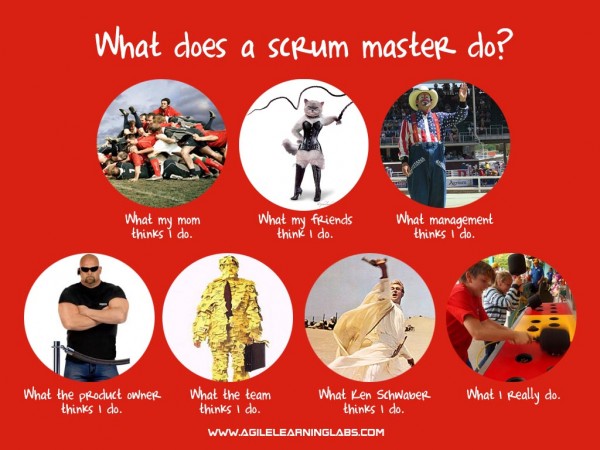One of my fellow Certified Scrum Trainers, Henrik Kniberg, created this excellent video that describes agile software development from the point of view of the product owner. I’m really impressed, and I regularly share this with the participants in my Certified Scrum Master and Certified Scrum Product Owner workshops. Great job Henrik!
Category Archives: agile
Managing the Performance of Scrum Team Members
 A client recently contacted us for guidance regarding managing individual performance in a scrum environment. This is a growing company that successfully adopted scrum a few years back. They asked me what they should do with a scrum team member that is not performing. Should they implement a performance management system, and if so, how? Read the full article…
A client recently contacted us for guidance regarding managing individual performance in a scrum environment. This is a growing company that successfully adopted scrum a few years back. They asked me what they should do with a scrum team member that is not performing. Should they implement a performance management system, and if so, how? Read the full article…
Where Do Quality Engineers Fit On A Scrum Team?
Question:
Hi Chris. It was great to have you in Beijing and you provided us with awesome Certified Scrum Master and Certified Scrum Product Owner trainings. We are having internal discussions about the role of quality engineers in scrum. Should they be on the scrum teams? Do we need quality engineers if we are doing scrum? If we have them, who should manage them? Should we move them around from team to team?
Answer:
Where Does User Experience Fit On A Scrum Team?
 Should a scrum team include user experience design professionals or should they be separate from the the scrum team? I’m often asked this question by UX designers and managers when their organization adopts scrum. Here is an email I received recently.
Should a scrum team include user experience design professionals or should they be separate from the the scrum team? I’m often asked this question by UX designers and managers when their organization adopts scrum. Here is an email I received recently.
My company is making a transition from waterfall to agile development using the guidelines from your book The Elements of Scrum. In your coaching of various companies, I was wondering if you’ve worked with teams that have user experience designers (UX) and where they’ve fit into the process. As a manager, I wanted to get your thoughts on whether it makes more sense for individuals with these skills to be part of a scrum team as a team member or work with the product owner as a stakeholder.
Thanks,
K
Answer:
The short answer is, “It depends.” I’ve seen both approaches work: have the user experience people on the scrum team, or have the UX person be part of the product owner’s inner circle of advisors but not actually on the scrum team. Let’s look at each approach.
Read the full article…
Dymaxicon Leaves the Nest
A couple of years ago, Hillary Louise Johnson and I had nearly finished writing The Elements of Scrum and we were discovering that the options for publishing it through traditional means didn’t satisfy us. A traditional publishing deal wouldn’t give us the creative control we wanted, and the royalty terms offered by traditional publishers weren’t to our liking. The answer, Hillary saw, was to start a publishing company; Dymaxicon was born.
Hillary had big plans right from the start. “Because of my years spent as a journalist and author, I had a huge backlog of books I knew of that had never found a home with traditional publishers,” she says. “So I started making calls.”
Read the full article…
Agile Performance Reviews
 I recently received the following question about performance reviews from a human resources professional at an organization that is adopting agile development practices.
I recently received the following question about performance reviews from a human resources professional at an organization that is adopting agile development practices.
Question:
My organization is just starting to use Agile and the question regarding performance management and specifically how performance reviews were now going to be done for the employees came up. Everyone turned to the HR team for the answer so I’m doing some research on this.
It appears in the agile world, some coaches and practitioners will say “there should be no such thing as performance management” but I’m hoping people recognize this is a reality in the corporate world and needs to be addressed. Currently our performance management system is based on an annual cycle and individual performance reviews/assessments are completed by the managers for their direct reports.
Can you share with me how organizations are addressing performance management and specifically performance reviews/assessments for individual employees that are on agile teams?
Read the full article…
Hear Chris Sims on the Agile Weekly Podcast
In Integrum, Chris talks to Roy van de Water and Drew LeSeur of Integrum about running Agile Learning Labs as a transparent company with a radical compensation plan, writing The Elements of Scrum using scrum, and how our new book, Scrum: A Breathtakingly Brief and Agile Introduction is an iteration of our first one.
Roy and Drew ask some excellent and hard questions, so tune in and give a listen!
Want a smart team? Make sure it gets the recommended daily allowance of estrogen
 A team without a woman is like a bicycle with… some fish? So it would seem, according to Grace Nasri, who writes in the HuffPo about the gender gap in tech from an interesting perspective. She got my attention with a 2011 HBR story profiling research by Anita Wooley and Thomas Malone showing that the one significant factor that demonstrably upped the measurable collective intelligence of a team was the presence of females on it.
A team without a woman is like a bicycle with… some fish? So it would seem, according to Grace Nasri, who writes in the HuffPo about the gender gap in tech from an interesting perspective. She got my attention with a 2011 HBR story profiling research by Anita Wooley and Thomas Malone showing that the one significant factor that demonstrably upped the measurable collective intelligence of a team was the presence of females on it.
Read the full article…
Scrum Product Owner vs. Product Manager: Is There a Difference?
Question:
Chris just did a scrum workshop for us and it was GREAT–I learned a TON. I have a follow-up question about the scrum role of product owner, and how we should implement it in our organization. The way we are doing this, the product owner is also the product manager. Is this typical? This seems potentially like two different jobs to me–one who goes to customers and gathers requirements, and one who is available during the sprint to answer questions about how things should work. I asked one of our brand new POs how he was going to do this, and he said that once the sprint starts, he does not need to work with the team. This was not my understanding, but I’m not sure.
Answer:
On very large projects, it is common to have a high-level product manager setting the over-all direction for a product. That product manager might work with several teams, each of which might have their own product owner. Each product owner would maintain the backlog for their team. It might be true that the product manager is a bit more customer-facing and the product owner a bit more team-facing. That said, you don’t want the product owner to simply be a pass-through between the product manager and the team; what value would they be adding? Instead, you want the product owners to work closely with the product manager, customers, and the other product owners in order to understand and prioritize (order) the stories in their team’s product backlog in way that supports the overall direction and goals.
It sounds like your new product owner has the common misconception that all they have to do is capture requirements and then relay them to the team. If only it were that easy. In reality, it’s a lot of work to truly understand the needs of users and customers, as well as the needs of our own business. Once a product owner has this understanding, it’s also a lot of work to help the whole team share this understanding.
Read the full article…
Fun with internet memes: “What does a scrum master do?”
Inspired by Lesbians and Lawyers. Click the image to see at full size:
If this makes you want to become a scrum master, you can take one of our certification classes. The next one is February 27-28, and includes a free Kindle.

